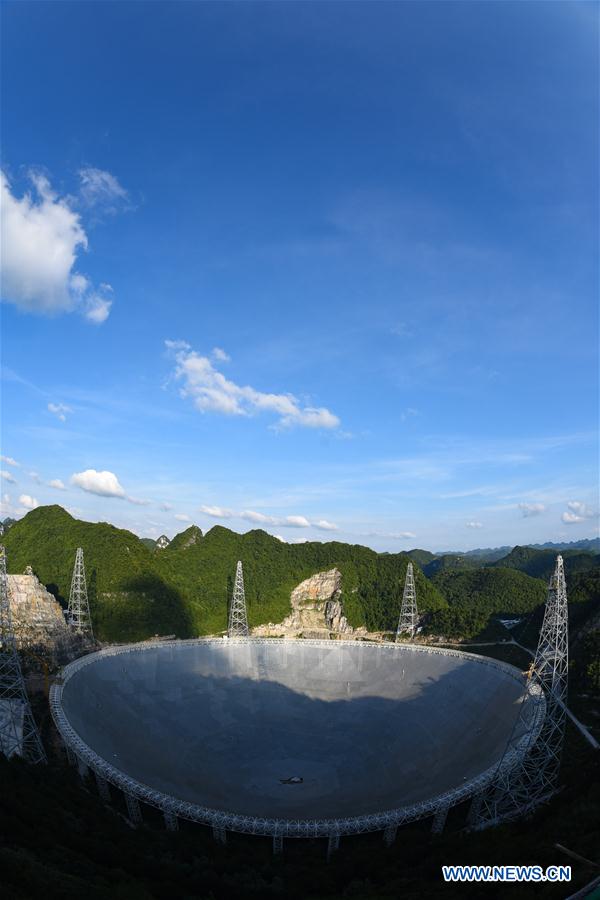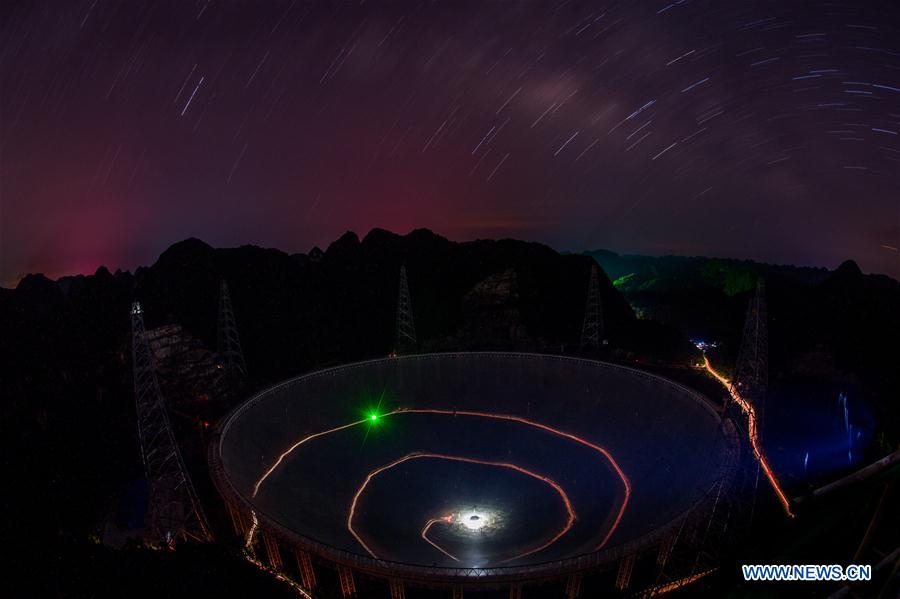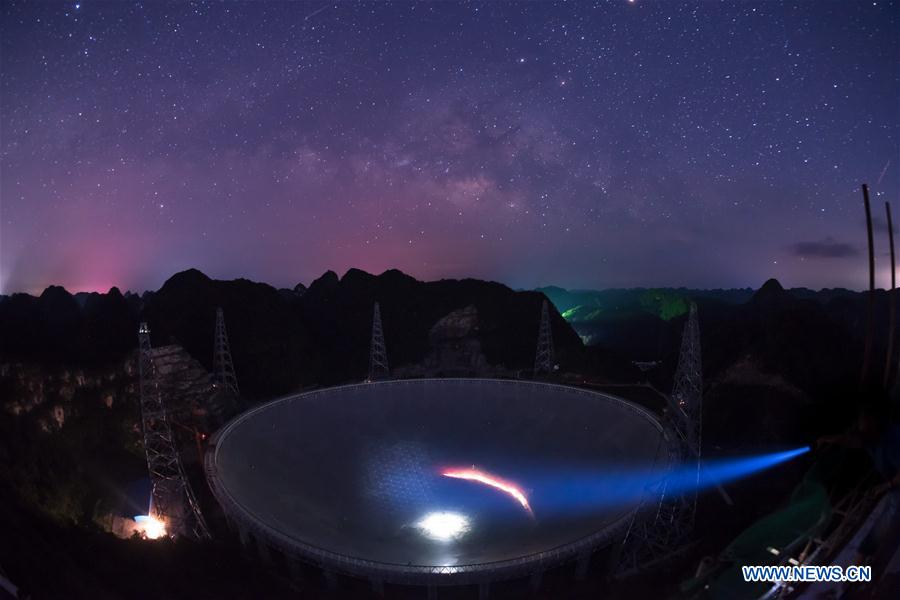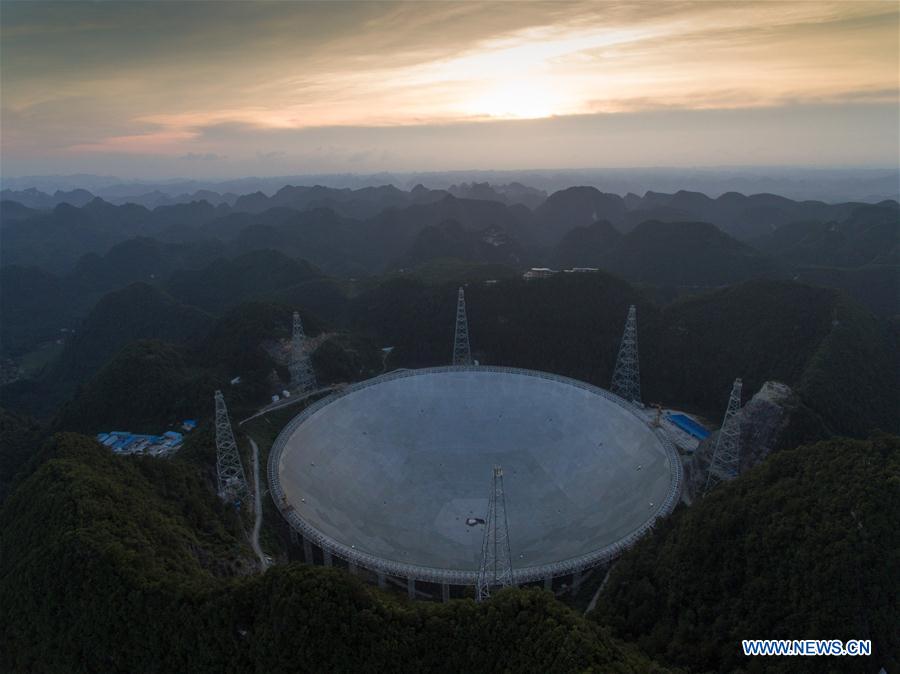

Photo taken on June 27, 2016 shows the Five-hundred-meter Aperture Spherical Telescope, or "FAST," at sunset in Pingtang County, southwest China's Guizhou Province. Construction of the world's largest telescope FAST started in March 2011. The telescope will be used to detect and collect signals and data from the universe. [Photo: Xinhua/Liu Xu]
The finishing touches are being put to the 500-meter Aperture Spherical Telescope, or FAST, in southwest China's Guizhou province.
Only seven panels out of over 4-thousand remain to be installed on the world's largest single-dish radio telescope.
The project will then move on to the debugging phase before the telescope goes into official operation.
The phase will also include testing two database centers and a temporary control center which have recently been set up.
Yue Youling, an associate researcher at the Chinese Academy of Sciences, says the database has a huge capacity.
"Its data processing ability is equal to that of 50 to 100 home computers. Its storage capacity is 1.6 petabytes (PB), about 1,000 times the storage capacity of a home computer."
Experts say the two database centers' capacity is enough to store the data collected by the telescope for a year.
The radio telescope will help scientists with studies to reproduce the images of the early universe. It is also prepared to participate in the search for extraterrestrial civilization. (CRIEnglish.com)

Photo taken on June 27, 2016 shows the Five-hundred-meter Aperture Spherical Telescope, or "FAST," at sunset in Pingtang County, southwest China's Guizhou Province. Construction of the world's largest telescope FAST started in March 2011. The telescope will be used to detect and collect signals and data from the universe. [Photo: Xinhua/Liu Xu]

Photo taken on June 27, 2016 shows the Five-hundred-meter Aperture Spherical Telescope, or "FAST," at sunset in Pingtang County, southwest China's Guizhou Province. Construction of the world's largest telescope FAST started in March 2011. The telescope will be used to detect and collect signals and data from the universe. [Photo: Xinhua/Liu Xu]

Photo taken on June 27, 2016 shows the Five-hundred-meter Aperture Spherical Telescope, or "FAST," at sunset in Pingtang County, southwest China's Guizhou Province. Construction of the world's largest telescope FAST started in March 2011. The telescope will be used to detect and collect signals and data from the universe. [Photo: Xinhua/Liu Xu]

Photo taken on June 27, 2016 shows the Five-hundred-meter Aperture Spherical Telescope, or "FAST," at sunset in Pingtang County, southwest China's Guizhou Province. Construction of the world's largest telescope FAST started in March 2011. The telescope will be used to detect and collect signals and data from the universe. [Photo: Xinhua/Liu Xu]

Photo taken on June 27, 2016 shows the Five-hundred-meter Aperture Spherical Telescope, or "FAST," at sunset in Pingtang County, southwest China's Guizhou Province. Construction of the world's largest telescope FAST started in March 2011. The telescope will be used to detect and collect signals and data from the universe. [Photo: Xinhua/Liu Xu]

Photo taken on June 27, 2016 shows the Five-hundred-meter Aperture Spherical Telescope, or "FAST," at sunset in Pingtang County, southwest China's Guizhou Province. Construction of the world's largest telescope FAST started in March 2011. The telescope will be used to detect and collect signals and data from the universe. [Photo: Xinhua/Liu Xu]
 .
.
Photo taken on June 27, 2016 shows the Five-hundred-meter Aperture Spherical Telescope, or "FAST," at sunset in Pingtang County, southwest China's Guizhou Province. Construction of the world's largest telescope FAST started in March 2011. The telescope will be used to detect and collect signals and data from the universe. [Photo: Xinhua/Liu Xu]

86-10-68597521 (day)
86-10-68597289 (night)

52 Sanlihe Rd., Xicheng District,
Beijing, China (100864)

